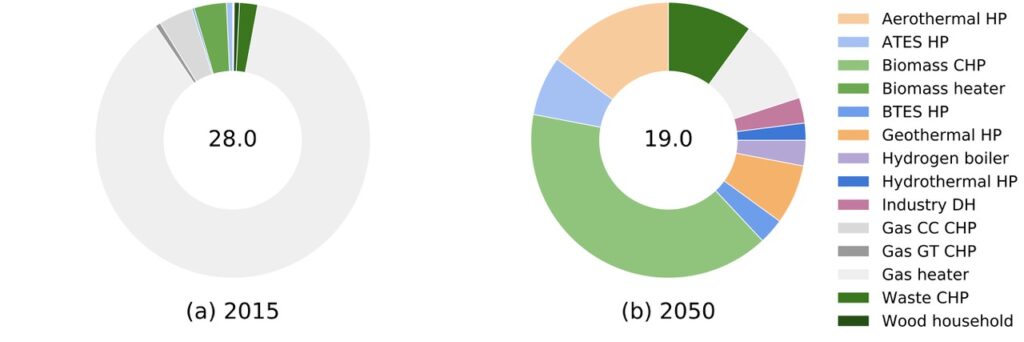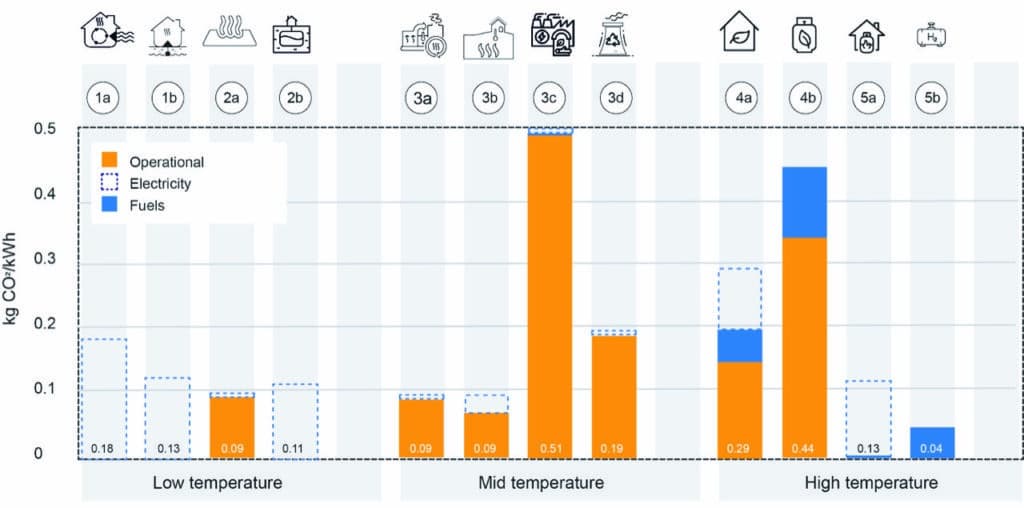Join JPI UE
Faq
FAQ
Please click here for the frequently asked questions we collected.
If you have an additional questions you are welcome to mail us at info@jpi-urbaneurope.eu
Arguably, security is a key driver for the energy transition: the tragic war in Ukraine has brought to attention significant vulnerabilities in national energy systems across Europe. A pertinent fact is that Russia currently provides 40% of the EU’s gas imports. A significant amount of this energy is used for heating. However, sustainability and resilience goals are also crucial factors. These drivers have already committed several European governments to decreasing their reliance on natural gas. Staying within the global warming carbon budget of 1.5 °C is vital for avoiding an increase in climate change related disasters. Setting this ambition not only requires the installation of heating technologies that reach carbon neutrality by 2050, but also consideration of the greenhouse gas emissions of these technologies before and after this milestone. Given the path dependence and the long-life spans of energy infrastructure and building shells, carbon-intensive infrastructure may persist over time, creating a ‘carbon lock-in,’ which ‘locks out’ lower-carbon alternatives.
Therefore, meeting ambitious climate targets requires a careful understanding of how low-carbon heating technologies function optimally in a mixed energy system, which may include existing carbon-intensive infrastructure. This is why the ENLARGE project’s work in Amsterdam is well placed to offer useful knowledge for creating a renewables-rich and more mixed heating system, as the project both offers key insights for meeting the Netherlands national goal of making heating gas-free by 2050 and in creating widely applicable decision-making models for building mixed energy systems. Dr. Edo Abraham tells us how, within the ENLARGE project, financed in the SUGI Food-Water-Energy Nexus call, he and PhD student Chelsea Kaandorp, research the Heating Transition in Amsterdam. They analyse it using three indicators: water use, carbon emissions and energy justice. They explain how their work offers a comprehensive evaluation of existing technologies, provides a model for determining how to optimally use these technologies together, as well providing quantitative data on the water withdrawal rates of these technologies.
How else can heat be generated other than by incinerating natural gas? The project produced an extensive evaluation of existing technologies to answer this question. It shows that one option is the use of district heating: taking thermal energy generated by power plants, biomass heaters, industrial actors and data centres, and then combining it and distributing it via a heat network. The project also highlights the benefits and disadvantages of options such as burning biofuels or extracting thermal energy from the air or extracting it from ground water.
Adaptive heating infrastructure planning requires a mix of different heating technologies and energy sources working together
It is important to note, a resilient energy system would not rely on any single heating technology, doing so may replicate the vulnerabilities faced today. Instead, adaptive heating infrastructure planning requires a mix of different heating technologies and energy sources working together. Additionally, neighbourhoods, for example within historic city centres and newly built areas, differ from each other in their availability of building stock, space in the underground and the capacity of the power grid, influencing which heating options are the most economically viable and practically possible. Within the ENLARGE project’s evaluation work, the impacts of all these technologies were considered at multiple levels (global, national, urban) in order to analyse the multi-scalar (multi-scale) impacts of different technology mixes on both water use and carbon emissions.
Determining the feasibility and environmental impact of different heating technologies and finding the optimal mix of these technologies is a complex process, especially when considering the differences between different city neighbourhoods. Dr. Abraham explains that feasibility of installation, and the CO2 emissions of heating technologies are determined by the size of the heat demand per household. Heat pumps, for example, are more efficient in well-insulated buildings. Additionally, the CO2 emissions of heating technologies are determined by the carbon footprint of their electricity use. In order to get more insights into these complex dependencies, the ENLARGE team has built an optimisation model to establish which heating technologies produce the least carbon emissions per neighbourhood for different rates of building insulation and decarbonisation of electricity supply. Since the municipality organises participation for decision-making on a neighbourhood scale, ENLARGE’s modelling framework is also applied on a neighbourhood level, generating information at decision-relevant scales, which can be aggregated to city level emissions. ENLARGE considered a rich mix of supply systems and energy sources that are currently under consideration within national policy forums and practices. This use of the neighbourhood scale is significant as cities across the world are now seriously considering decentralised decision-making structures for energy provision.

Figure 1: Heat technology mixes for 2015 and 2050 scenarios for the city of Amsterdam. The amount of energy generated per scenario is presented in units of petajoules (PJ) in the middle of the doughnut diagrams. Abbreviations: ATES = aquifer thermal energy storage, BTES = borehole thermal energy storage, CC = combined cycle, CHP = combined heat and power, GT = gas turbine. Figure from (Kaandorp et al, 2021).
The results of the optimisation model show that ambitious insulation rates for buildings and the decarbonisation of the electricity grid can significantly decrease carbon emissions by 2050. Therefore, setting ambitious plans for the insulation of buildings and the decarbonisation of electricity supply are the most important factors for reducing CO2 emissions produced by space heating (heating for homes, offices etc.). Additionally, the rates of building insulation and the decarbonisation of electricity supply influenced the optimal technology mix within the model. Since these rates are difficult to predict, ENLARGE argues for adaptive planning, implementing heating options in stages and avoiding costly stranded assets (a piece of equipment, infrastructure or a resource that prematurely loses value and productivity).

Figure 2: Carbon emissions in terms of CO2-equivalents per kWh of different heat systems: (1a) Heat Pump (HP) Aerothermal, (1b) HP Underground, (2a) Residual Heat Low Temperature (LT), (2b) Underground Thermal Energy Storage (UTES), (3a) Residual Heat Mid Temperature (MT), (3b) Geothermal Energy, (3c) Biomass Heater, (3d) Waste Combined Heat and Power (CHP) plant, (4a) Green Gas Hybrid, (4b) Green Gas Boiler, (5a) Hydrogen Hybrid, and (5b) Hydrogen Boiler.
Dr. Abraham explains that many forms of energy generation are water intensive, consequently climate-change related effects, such as droughts, and increased water temperature, can limit energy security. At the same time, monitoring and regulating water use for energy production is important for supporting biodiversity and clean water supply. Using a water-energy nexus approach (an approach that looks at energy and water systems as an integrated whole) the project team assessed scenarios for different energy mixes and their impact on water use in order to inform the decision-making processes on renewable heating options for the built environment on both the urban and national scale. This work is presented in the journal article ‘The water use of heating pathways to 2050: analysis of national and urban energy scenarios,’ published in Environmental Research Letters.
ENLARGE calls for more research and improved regulation on the ecological impacts of water use for the heating systems of the future.
One of the results from this study shows that the amount of water withdrawal for ATES (aquifer thermal energy storage) in 2050 can become as significant as the water withdrawal of thermoelectric power plants in 2015, even if only around a tenth of the heating in the Netherlands is supplied with this technology. Additionally, the increased use of hydrothermal energy, i.e., thermal energy extraction from surface water, can introduce significant changes to the temperature of surface water bodies. Consequently, ENLARGE calls for more research and improved regulation on the ecological impacts of water use for the heating systems of the future.
The ongoing work of the ENLARGE team studies citizens’ initiatives for renewable heating in the city of Amsterdam. Retro-fitting houses and installing new heating infrastructures raises questions about the procedures of decision-making processes and the distribution of costs and benefits of plans made. ENLARGE sheds light on these questions with ethnographic fieldwork, following citizens’ initiatives and interviewing citizens, urban professionals, and decision-makers. Using the concepts of ‘energy justice’ and the ‘urban commons,’ the results of the project will be presented in the near future.
You cannot transition heating sustainably and equitably without considering interrelations with other systems and questions about energy justice
ENLARGE’s work has highlighted the need for two vital actions. First, cities need to inform decision-making for heating provision with intersectoral assessments. In this way, emerging problems, such as energy insecurity, water use and quality issues, carbon emissions, and energy justice are addressed when transitioning away from natural gas and other fossil fuels. Using an integrated approach, this project has shown how heating provision can impact water use, carbon emissions and socio-political structures. In the upcoming final months, the project will be occupied with finalising its findings and sharing its insights to its partners connected to both government and academia, such as the AMS institute in Amsterdam. Dr. Abraham finishes by saying, “in this project, we have seen that you cannot transition heating sustainably and equitably without considering interrelations with other systems and questions about energy justice.”
Further reading on the project:
Paper by Kaandorp et al: https://iopscience.iop.org/article/10.1088/1748-9326/abede7/meta
Policy brief: https://jpi-urbaneurope.eu/wp-content/uploads/2021/09/Policy-Brief-JPI-Eurban-Europe-ENLARGE.pdf